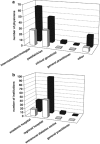A decade of molecular genetic testing for MODY: a retrospective study of utilization in The Netherlands
- PMID: 24736738
- PMCID: PMC4266743
- DOI: 10.1038/ejhg.2014.59
A decade of molecular genetic testing for MODY: a retrospective study of utilization in The Netherlands
Abstract
Genetic testing for maturity-onset diabetes of the young (MODY) may be relevant for treatment and prognosis in patients with usually early-onset, non-ketotic, insulin-sensitive diabetes and for monitoring strategies in non-diabetic mutation carriers. This study describes the first 10 years of genetic testing for MODY in The Netherlands in terms of volume and test positive rate, medical setting, purpose of the test and age of patients tested. Some analyses focus on the most prevalent subtype, HNF1A MODY. Data were retrospectively extracted from a laboratory database. In total, 502 individuals were identified with a pathogenic mutation in HNF4A, GCK or HNF1A between 2001 and 2010. Although mutation scanning for MODY was used at an increasing rate, cascade testing was only used for one relative, on average, per positive index patient. Testing for HNF1A MODY was mostly requested by internists and paediatricians, often from regional hospitals. Primary care physicians and clinical geneticists rarely requested genetic testing for HNF1A MODY. Clinical geneticists requested cascade testing relatively more often than other health professionals. A substantial proportion (currently 29%) of HNF1A MODY probands was at least 40 years old at the time of testing. In conclusion, the number of individuals genetically tested for MODY so far in The Netherlands is low compared with previously predicted numbers of patients. Doctors' valuation of the test and patients' and family members' response to (an offer of) genetic testing on the other hand need to be investigated. Efforts may be needed to develop and implement translational guidelines.
Figures


Similar articles
-
Identification of HNF1A-MODY and HNF4A-MODY in Irish families: phenotypic characteristics and therapeutic implications.Diabetes Metab. 2011 Dec;37(6):512-9. doi: 10.1016/j.diabet.2011.04.002. Epub 2011 Jun 16. Diabetes Metab. 2011. PMID: 21683639
-
Clinical application of ACMG-AMP guidelines in HNF1A and GCK variants in a cohort of MODY families.Clin Genet. 2017 Oct;92(4):388-396. doi: 10.1111/cge.12988. Epub 2017 Apr 12. Clin Genet. 2017. PMID: 28170077
-
Co-inheritance of HNF1a and GCK mutations in a family with maturity-onset diabetes of the young (MODY): implications for genetic testing.Clin Endocrinol (Oxf). 2013 Sep;79(3):342-7. doi: 10.1111/cen.12050. Epub 2013 Apr 1. Clin Endocrinol (Oxf). 2013. PMID: 23009393
-
Maturity onset diabetes of the young: Seek and you will find.Neth J Med. 2016 Jun;74(5):193-200. Neth J Med. 2016. PMID: 27323672 Review.
-
Half-Life of Sulfonylureas in HNF1A and HNF4A Human MODY Patients is not Prolonged as Suggested by the Mouse Hnf1a(-/-) Model.Curr Pharm Des. 2015;21(39):5736-48. doi: 10.2174/1381612821666151008124036. Curr Pharm Des. 2015. PMID: 26446475 Review.
Cited by
-
Diagnosis, treatment and disclosure: A qualitative exploration of participant challenges in a Monogenic Diabetes Registry.Genet Med. 2023 Apr;25(4):100019. doi: 10.1016/j.gim.2023.100019. Epub 2023 Jan 20. Genet Med. 2023. PMID: 36681871 Free PMC article.
-
A Unique Phenotype of Maturity-Onset Diabetes of the Young With a Novel Disease-Causing Insulin Gene Variant.JCEM Case Rep. 2024 Dec 23;3(1):luae230. doi: 10.1210/jcemcr/luae230. eCollection 2025 Jan. JCEM Case Rep. 2024. PMID: 39717432 Free PMC article.
-
Diabetes and Familial Hypercholesterolemia: Interplay between Lipid and Glucose Metabolism.Nutrients. 2022 Apr 3;14(7):1503. doi: 10.3390/nu14071503. Nutrients. 2022. PMID: 35406116 Free PMC article. Review.
-
Meta-analysis of HNF1A-MODY3 variants among human population.J Diabetes Metab Disord. 2022 Feb 2;21(1):1037-1046. doi: 10.1007/s40200-022-00975-8. eCollection 2022 Jun. J Diabetes Metab Disord. 2022. PMID: 35673428 Free PMC article. Review.
-
Maturity Onset Diabetes of the Young-New Approaches for Disease Modelling.Int J Mol Sci. 2021 Jul 14;22(14):7553. doi: 10.3390/ijms22147553. Int J Mol Sci. 2021. PMID: 34299172 Free PMC article. Review.
References
-
- Shields BM, Hicks S, Shepherd MH, Colclough K, Hattersley AT, Ellard S. Maturity-onset diabetes of the young (MODY): how many cases are we missing. Diabetologia. 2010;53:2504–2508. - PubMed
-
- Ledermann HM. Is maturity onset diabetes at young age (MODY) more common in Europe than previously assumed. Lancet. 1995;345:648. - PubMed
-
- Vaxillaire M, Froguel P. Genetic basis of maturity-onset diabetes of the young. Endocrinol Metab Clin North Am. 2006;35:371–384. - PubMed
-
- Murphy R, Ellard S, Hattersley AT. Clinical implications of a molecular genetic classification of monogenic beta-cell diabetes. Nat Clin Pract Endocrinol Metab. 2008;4:200–213. - PubMed
Publication types
MeSH terms
Substances
Supplementary concepts
LinkOut - more resources
Full Text Sources
Other Literature Sources
Medical
Miscellaneous

